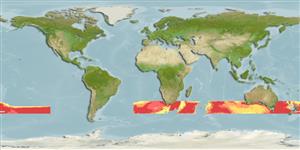Environment: milieu / climate zone / depth range / distribution range
Ecologie
marien bathypelagisch; diepte 1140 - 1630 m (Ref. 44037). Deep-water; 31°S - 46°S
Eastern Atlantic: South Africa: Indo-West Pacific: South Africa to New Zealand.
Grootte / Gewicht / Leeftijd
Maturity: Lm ? range ? - ? cm
Max length : 30.0 cm TL mannelijk / geslacht onbekend; (Ref. 6598)
Korte beschrijving
Determinatiesleutels | Morfologie | Morfometrie
Dorsale stekels (totaal) : 0; Dorsale zachte stralen (totaal) : 19 - 21; Anale stekels: 0; Anale zachte stralen: 15 - 17.
Levenscyclus en paargedrag
Maturiteit | Voortplanting | Paaien | Eieren | Fecunditeit | Larven
Matsui, T. and R.H. Rosenblatt, 1986. Platytroctidae. p. 223-225. In M.M. Smith and P.C. Heemstra (eds.) Smiths' sea fishes. Springer-Verlag, Berlin. (Ref. 6598)
Status op de Rode Lijst van het IUCN (Ref. 130435: Version 2024-1)
Gevaar voor de mens
Harmless
Gebruik door de mens
Visserij: van geen belang
Tools
Speciale rapporten
Download XML
Internetbronnen
Estimates based on models
Preferred temperature (Ref.
123201): 2.9 - 4.4, mean 3.8 °C (based on 77 cells).
Fylogenetische diversiteitsindex (Ref.
82804): PD
50 = 0.5020 [Uniqueness, from 0.5 = low to 2.0 = high].
Bayesian length-weight: a=0.00407 (0.00154 - 0.01080), b=3.17 (2.94 - 3.40), in cm total length, based on LWR estimates for this (Sub)family-body shape (Ref.
93245).
Trofisch niveau (Ref.
69278): 3.4 ±0.5 se; based on size and trophs of closest relatives
Weerstandsvermogen (Ref.
120179): Gemiddeld, minimale populatieverdubbelingstijd 1,4-4,4 jaar (Assuming tmax>3).
Fishing Vulnerability (Ref.
59153): Low vulnerability (20 of 100).
